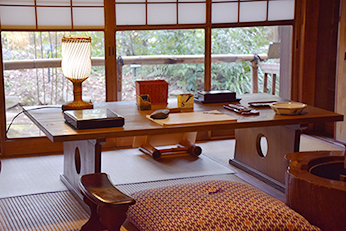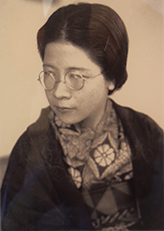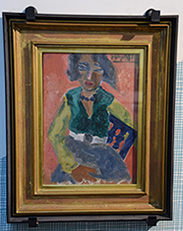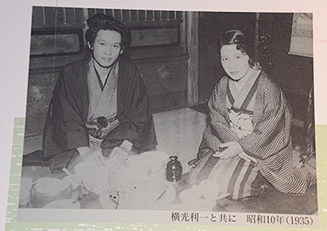 |
Focus features two in-depth reviews each month of fine art, architecture and design exhibitions and events at art museums, galleries and alternative spaces around Japan. The contributors are non-Japanese art critics living in Japan. |
|
|
 |
 |
 |
A Home, Workplace, and Garden of Her Own: Fumiko Hayashi Memorial Hall
Michael Pronko |
 |
The simple interior of the house was painstakingly designed by Hayashi and a series of architects, builders, and designers. She was able to buy the home after the success of her early novels, and lived there for part of her life with her mother and her son. |
|
The garden is designed by Hayashi and includes a yearlong succession of blooming flowers and trees. She worked closely with the architects of the buildings and garden to achieve an optimally balanced work-life space. |
Sometimes creative people are destined to live in the wrong time. Novelist, poet, painter, and feminist Fumiko Hayashi (1903-51) had a way of writing and a way of living that went against the pressures and expectations of Japanese society. The tensions in her life created powerful and popular works rich with humanity and the strength of women. Her writing also showed the underside of Japanese society, honing in on the injustices of the age, during a period of great upheaval and change.
None of that conflict or criticism is apparent in the Fumiko Hayashi Memorial Hall, however. Instead, this museum, which was her residence for the last ten years of her life, is a calm, reflective, and lovely place, which any writer in any age would be happy to call home. The rooms, divided into two wings because of building codes at the time, are open on all sides, but far from lavish. She created a place not to impress, but to live and work and enjoy life. And so, her home and garden impresses all the more.
Having wandered around in her youth as the daughter of an itinerant merchant, and after a succession of lovers, she finally settled into marriage with painter Ryokubin Tezuka in Tokyo. After her literary success following the publication of the autobiographical novel Horoki (Diary of a Vagabond) in 1930, she was able to afford the land and she set down to design the house, working closely with the architects, carpenters, and builders and reading over 200 books on building homes. The house was constructed according to her specifications over a period of years.
 |
|
 |
|
|
|
Looking out on her garden, Hayashi's desk seems the perfect place to write, affording her a calm, peaceful environment, with a view of Tokyo beyond the garden as a reminder of the social drama she wrote about. |
|
A photo of Hayashi in her early years as a writer, soon after the success of her first novels. She became known for her exploration of the female psyche and her criticism of society's worst problems. |
The location -- on the side of a hill in Nakai, a tranquil residential area west of Takadanobaba -- took a long time to excavate before the years-long building process began. But the result is a delightful space. The traditional interior is open to view from outside, and speaks of comfort and security in traditional tatami-based style. The two wings branch out, revealing the two sides of her personality -- her public success and her chronic private worries about money, acceptance, and work.
Horoki, which described an early life of poverty from a woman's perspective, made her an overnight sensation. For the next two decades she wrote constantly, and her early death in 1951 may have been caused by overwork. The entryway to the home has a small room where writers, editors, or publishers would wait for her to wake up and deliver the previous day's manuscript.
Hayashi perhaps never received the acclaim she deserved. For one thing, she wrote about women from their own point of view. Women were often featured in the melodramatic, emotional literature of the time, but Hayashi's work went beyond the easy confines of popular literature and delved into the humanity of women and the social injustices they suffered.
 |
|
 |
|
|
|
In addition to being a novelist and poet, Hayashi was a painter. This oil is a self-portrait. The exhibit area, converted from a western-style storehouse, holds several of her paintings. |
|
Very much part of the prewar modernist literary scene, Hayashi here sits with Riichi Yokomitsu, an experimental writer. Hayashi's early writings were part of the "I-novel" movement, which sought more personal and interior expression while also exposing the darker side of society and human experience. |
After the war, she fell under suspicion for having been drafted as a writer to report on the military's occupation of China. Those themes and her writing style were reason enough for conservative critics to dismiss her work from serious consideration. Fortunately, film director Mikio Naruse turned many of her novels into classic films, notably Horoki (1962), which immortalized her work and life.
Now, however, a foundation under the jurisdiction of Shinjuku Ward has restored her home, along with her reputation, to its rightful position. A visit to the beautiful grounds, residence, and exhibition space reveals how she lived as a writer. You can see in the rooms her daily routine; her writing desk enjoys a fine view of the garden and off through the trees and bamboo. She was also a painter, and a handful of her works are on display, along with first editions of her novels.
The entire space is more than just "a room of her own." It's the home, garden, and workplace of a free-spirited woman who is now wonderfully memorialized.
The house sits on a hillside overlooking the Tokyo cityscape. The home and garden are a soothing place to visit, with plenty of benches on which to sit and reflect.
|
| All photographs by Michael Pronko, with the permission of the Shinjuku Historical Museum.
|
 |
|
| |
2-20-1 Nakai, Shinjuku-ku, Tokyo
Phone: 03-5996-9207
Open: 10 a.m. to 4:30 p.m., last entry at 4 p.m.; closed Mondays
Access: 5-minute walk from Nakai Station on the Seibu-Shinjuku and Toei Oedo Lines |
 |
 |
Michael Pronko
Michael Pronko teaches American literature, film, art and music at Meiji Gakuin University. He has appeared on NHK, Sekai Ichiban Uketai Jugyo, and other TV programs. His publications include several textbooks and three collections of essays about Tokyo. He writes regular columns for Newsweek Japan, ST Shukan, The Japan Times, and for his own websites, Jazz in Japan and Essays on English in Japan. |
|
 |
|